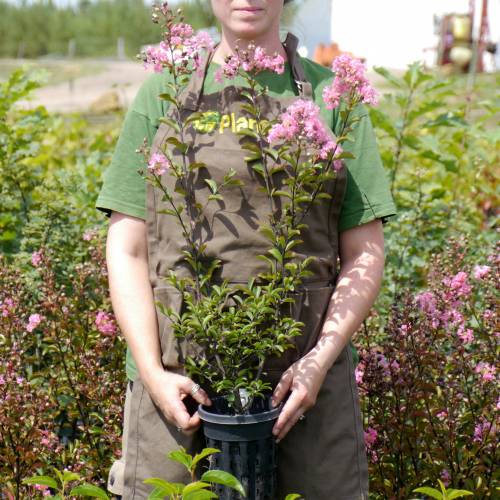A Blooming Marvel Miami Pink Crepe Myrtle
The Miami Pink Crepe Myrtle known as Lagerstroemia originates from Asia where its ancestral forms existed for many centuries before reaching Western societies. The Swedish merchant Magnus von Lagerström introduced the trees and shrubs of the genus Lagerstroemia to European botanists who then named it in his honor. By the 18th century they traveled to North America where selective breeding resulted in vibrant cultivars such as ‘Miami Pink.’
Gardeners chose this variety because of its exceptional resilience combined with stunning pink flowers and its strong disease resistance. The southeastern United States embraced this plant as a landscape staple because of its popularity in areas with warm weather and abundant sun. Through meticulous breeding practices ‘Miami Pink’ developed into a highly desired variety because of its extended blooming season and its ability to flourish in various environmental conditions.
Miami Pink Crepe Myrtle Historical and Modern Medical Uses
The Lagerstroemia species serve mainly as ornamental plants but they also hold a longstanding history of use in traditional Asian and Indigenous medicinal practices. Traditional herbal remedies utilize the beneficial compounds found in the bark and leaves of these trees which include tannins and flavonoids.
Ancient herbal medicine practitioners utilized tree extracts to treat skin irritations, stimulate wound healing processes, and improve digestive health. Ancient cultures used this tree’s bark and leaves because they believed it had properties that reduced inflammation and maintained healthy blood sugar levels through teas and tinctures. Current research efforts focus on its potential diabetes management applications because preliminary studies indicate certain species from this genus may enhance insulin sensitivity.
Traditional applications of this plant have been mostly replaced by modern medicine, yet researchers are increasingly investigating its medicinal properties as they gain popularity in holistic medicine.
Discovery and Early Documentation

European explorers and botanists first recorded Pink Crepe Myrtle during the late 17th and early 18th centuries because they were impressed by its attractive appearance and extended blooming periods. The Pink Crepe Myrtle is a new cultivar developed by selective breeding techniques in the United States. The development of this variety aimed to produce trees that both resisted diseases and exhibited enhanced flowering features.
Horticulturists debated when it appeared in cultivation for the first time, yet its superior qualities led to official recognition in the late 20th century, which brought it widespread attention. Throughout the warm months, American gardens have routinely featured this plant because of its stunning pink floral presentation.
Miami Pink Crepe Myrtle An Icon in Modern Landscapes
Landscapers prefer Miami Pink Crepe Myrtle because it combines versatility with minimal maintenance requirements. People often use this tree as a standout feature in residential gardens as well as urban streetscapes and public parks because it delivers visual appeal throughout the entire year.
The combination of its small stature and vibrant pink flowers makes this plant perfect for creating borders along driveways and walkways. Clusters of this plant produce a magical canopy of vibrant colors which turns spaces into lively floral exhibitions. Horticulturists and city planners frequently select this tree type because it grows well in tough settings which makes it perfect for public settings.
This tree proves beneficial for gardens designed to support pollinators. The extended flowering time of this plant supplies nectar and pollen for bees and butterflies until late summer when pollinator activity remains high in urban and suburban areas.
A Stunning Display of Pink Elegance
Lagerstroemia ‘Miami Pink’ is admired for its beautiful appearance which evolves with each season. The tree’s deep green foliage creates a stunning backdrop for the soft pink flowers that appear in large clusters. The blooms appear at the start of summer and continue to show throughout fall creating prolonged colorful displays in landscapes.
Beyond its flowers, the tree's bark possesses its own distinctive aesthetic appeal. The mature tree displays peeling smooth bark that reveals patches of mottled soft browns and grays. This feature captivates viewers with its visual appeal all year round despite the lack of flowers during winter months.
The tree transforms its foliage into vibrant orange and red colors during autumn which forms a spectacular show before they fall off. Gardeners and landscapers choose ‘Miami Pink’ because its multi-seasonal qualities provide continual beauty throughout the year.
Miami Pink Crepe Myrtle A Haven for Rare Wildlife
The tree serves as an essential resource for wildlife by drawing numerous pollinators and birds who depend on its flowers and seeds for sustenance. Butterflies like swallowtails and monarchs benefit greatly from the plant because they are attracted to its abundant nectar production.
Because they perform pollination duties bees regularly gather nectar from its blossoms which support the vitality of local ecosystems. Hummingbirds use these flowers as a food source while they frequently fly around the branches to drink nectar.
This tree offers small birds shelter especially when it blooms and produces fruit. Songbirds like finches eat the small seed capsules that remain after flowers die off.